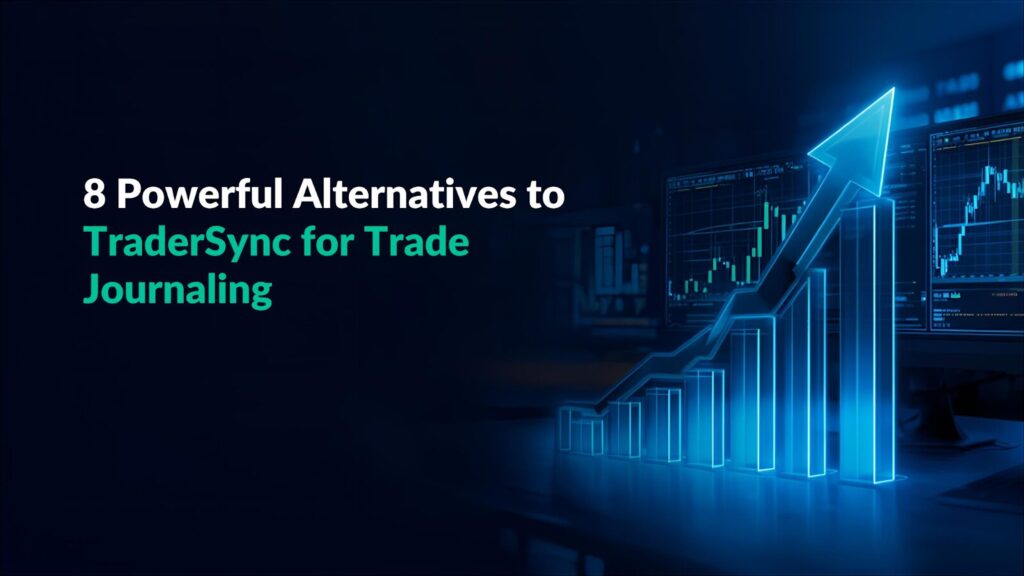
TraderSync is one of the best trading journals that we’ve seen for ease of use with the interface, combined with the well-integrated trade analytics.
Because of this, even TraderSync fans have found that TraderSync is not for everyone, and have launched out to find something more powerful, stable, or cost-effective.
If you’re looking for a trading journal that is suited to your style or budget better than the above options, these eight solid products offer anything from professional level analysis to quick, real time journaling for day trading improvement.
1. Tradervue: Best Overall Alternative for Professional Analytics
Tradervue remains the most respected and data-accurate trading journal on the market, used by professional traders, educators, and proprietary firms worldwide.
It prides itself on precision and reliability, not tricks or half-baked automation, tracking every detail.
Using the software, the trader can import trades from many brokers, tag them, and analyze them for any time period and trading strategy.
It displays profit factor, expectancy, drawdowns, and other analytics in easily digestible visual representations.
For the serious trader who thinks of reviewing his or her trading performance as a business analysis, Tradervue sets the gold standard.
Strengths
- Deep, accurate analytics trusted by professionals
- Automatic broker imports
- Reliable cloud-based reports and data history
- Proven stability over a decade of use
Weaknesses
- Paid plans are required for full analytics
- Interface favors data over aesthetics
- Slower feature release cycle
Best for: Traders who value precision and long-term consistency in their analytics.
2. RizeTrade: Best Free Alternative for Day Traders
RizeTrade is a trading journal designed to help day traders improve their timing, consistency, and execution by storing session-based perceptions.
In contrast to TraderSync’s design priorities, RizeTrade stresses speed of process and deliverable perceptions.
The app breaks down the trading day into four timeframes (pre-market, open, midday, close) so users can identify their most and least productive trading times.
With a clean, responsive, and intuitive web interface, you’re able to log your trades and thoughts in the moment.
RizeTrade’s focus on instant, session-based feedback is perhaps the best way to ease intraday trading.
Strengths
- 100% web-based and free to use
- Session-based structure built for day traders
- Fast journaling process
- Simple visual feedback loop
Weaknesses
- Limited integrations compared to premium journals
- Advanced analytics still being developed
Best for: Day traders who need real-time clarity and simplicity instead of layered, complex dashboards.
3. Edgewonk: Best for Mindset and Discipline Tracking
Edgewonk fills this gap as it allows a trader to record their psychological state, discipline, and confidence with each trade, building a direct connection between their mindset and their overall trading performance.
It helps traders recognize mental patterns, reinforce consistency, and make journaling a learning process rather than simply a filing of events.
Strengths
- Tracks emotional and behavioral factors
- One-time payment (no subscription fees)
- Proven to enhance discipline and mindset
Weaknesses
- Manual data entry
- Desktop-based application
- No real-time web access
Best for: Traders who want to strengthen discipline and self-awareness alongside technical performance.
4. TradesViz: Best for Deep Data Visualization
With hundreds of visualization techniques and customizable dashboards, TradesViz gives every data-driven trader what they need.
Traders can ask things like “Show all trades with the highest average drawdown this month” and get an answer instantly.
Its fully web-based interface makes it accessible from anywhere, and its AI-powered analytics provide perceptions that most journals cannot offer.
Strengths
- Advanced analytics and custom dashboards
- AI-driven reporting and visualization
- Multi-broker compatibility
Weaknesses
- Setup takes time for customization
- Can be overwhelming for beginners
Best for: Traders who view performance tracking as a quantitative process and want total data control.
5. Trademetria: Best for Simplicity and Habit Building
Trademetria is one of the simpler options for traders who want to get started with the process as quickly as possible.
The free option and easy-to-use web interface will be appealing to new and part-time traders looking to monitor their trades.
With a limited setup, you’ll have the ability to log trades, track performance, and review results.
It may not be as powerful as TraderSync or Tradervue, but its ease of use makes it a great first journal.
Strengths
- Free plan available
- Multi-account tracking
- Beginner-friendly workflow
Weaknesses
- Limited advanced metrics
- Basic data visuals
Best for: Traders who value simplicity over complexity and want to build the journaling habit.
6. Notion: Best Customizable Free Option
If you’d rather build your own trade log, Notion is a good alternative.
While Notion isn’t a dedicated trading journal tool, it allows you to create templates for notes, charts, performance logs, and more.
You can access your log from any web browser or mobile device.
Combine trading data with your emotions, learning notes, long term goals, and everything in between; perfect for hybrid trading learners and journaling enthusiasts.
Strengths
- Fully customizable web-based workspace
- Free for personal use
- Integrates reflection, notes, and journaling
Weaknesses
- Manual data entry
- No automated analytics
Best for: Creative traders who prefer building their own personalized journaling system.

7. Journalytix: Best for Live Analytics and Performance Coaching
Journalytix is initially aimed at prop traders. Journalytix combines analytics, coaching, and journaling in an online app, enabling users to track trades, determine performance patterns, and, for participating brokers, import trades automatically.
This will be especially useful for those who need structure.
Strengths
- Real-time analytics with broker integration
- Coaching tools and feedback
- Web-based and professional-grade
Weaknesses
- Premium-only access
- Designed more for advanced traders
Best for: Professional or proprietary traders who want live tracking and structured performance feedback.
8. Chartlog: Best for Visual Trade Tagging
Chartlog is an easy way to get data-driven visual charts, automatic imports, an intuitive tagging system, and a straightforward performance summary from a lightweight software dashboard accessed via a browser.
For those who enjoy TraderSync’s design but want something simpler, Chartlog has the same features on a basic level, but has a finer level of data.
Strengths
- Clean interface with fast data visualization
- Broker imports and tagging
- Web-based with mobile compatibility
Weaknesses
- Some advanced features behind paid plans
- Analytics are not as detailed as TradesViz or Tradervue
Best for: Traders who prefer visual summaries and quick, organized journaling.
Final Thoughts
TraderSync is a good platform, but it’s not the only platform out there, and probably not the best.
For professional-grade analysis and precision, choose Tradervue. RizeTrade, on the other hand, offers unmatched ease and clarity for day traders.
Edgewonk, TradesViz for advanced users, Trademetria, Notion (with a trading journal program), and Journalytix/Chartlog all have their pros and cons depending on your goals.
Instead of looking for the perfect journal, find one that you will use consistently.
A consistently used simple journal is better than a rarely used advanced one.












